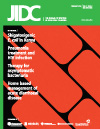Antimicrobial resistance in non-typhi Salmonella enterica isolated from humans and poultry in Palestine
DOI:
https://doi.org/10.3855/jidc.1167Keywords:
non-typhi Salmonella enterica, antibiotics, resistance, quinolones, gyrAAbstract
Introduction: The efficacy of chemotherapy can be compromised by drug resistance. This study was undertaken to describe the resistance profiles and fluoroquinolone resistance mechanism of non-typhoidal Salmonella (NTS) isolated from humans and poultry in West Bank, Palestine.
Methodology: One hundred and fifty-one isolates of NTS, obtained from humans (71) and poultry (80), collected between September 2005 and January 2007, were tested for susceptibility to ampicillin, gentamicin, tetracycline ceftriaxone, nalidixic acid and ciprofloxacin. Mutation patterns within gyrA were determined by direct sequencing or by digestion of PCR-amplified DNA fragments with the restriction enzyme HinfI.
Results: Resistance rates among human and poultry isolates were respectively 59% and 51% for ampicillin, 31% and 10% for gentamicin, 59% and 80% for tetracycline, 59% and 45% for nalidixic acid, and 30% and 15% for ciprofloxacin. All the isolates were susceptible to ceftriaxone. Mutations at positions 83 and/or 87 were detected in gyrA of isolates with resistance to nalidixic acid. Isolates which were resistant to nalidixic acid but susceptible to ciprofloxacin had a single gyr A gene mutation at point 87. This gene mutation was sufficient to induce a new phenotype (6 isolates) with decreased susceptibility to ciprofloxacin.
Conclusion: Mutations in gyrA at positions 83 or 87 were the most prevalent mutation pattern of fluoroquinolone resistant NTS isolates but other unknown mechanisms are also present. Continued surveillance of antimicrobial resistance among NTS isolates is needed to mitigate the increasing prevalence of quinolone resistance.
Downloads
Published
How to Cite
Issue
Section
License
Authors who publish with this journal agree to the following terms:
- Authors retain copyright and grant the journal right of first publication with the work simultaneously licensed under a Creative Commons Attribution License that allows others to share the work with an acknowledgement of the work's authorship and initial publication in this journal.
- Authors are able to enter into separate, additional contractual arrangements for the non-exclusive distribution of the journal's published version of the work (e.g., post it to an institutional repository or publish it in a book), with an acknowledgement of its initial publication in this journal.
- Authors are permitted and encouraged to post their work online (e.g., in institutional repositories or on their website) prior to and during the submission process, as it can lead to productive exchanges, as well as earlier and greater citation of published work (See The Effect of Open Access).








